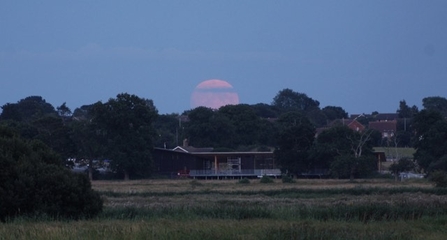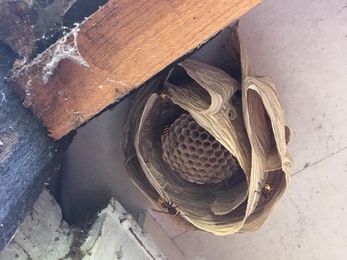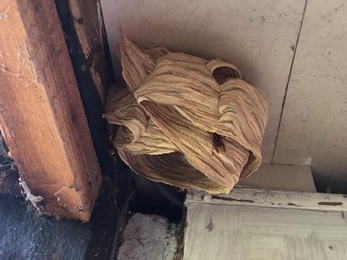Weekly wild news from our reserves, 7 August 2020
This spectacular hornet’s nest is under construction in the barn at Foxburrow Farm. Hornets are the UK’s largest wasp, and although some may find them fearsome-looking, the hornet is not aggressive and unlikely to sting unless provoked.
The queen hornet emerges from hibernation in spring and builds the papery nest from chewed up wood. Hornets usually nest in hollow trees, but occasionally use buildings instead. Inside the nest, sterile workers hatch and look after the new young produced by the queen. At the end of summer, reproductive males and queens develop and leave the nest to mate. The worker males and previous queen die, and the new females hibernate, ready to emerge next spring and start the cycle again.
Hornets catch a wide variety of invertebrates, mainly to feed to their larvae, and they feed themselves on high-energy substances like nectar and sap.
Flying ant day
'Flying ant day' is when winged adult ants, called alates, leave the nest to form new ant colonies, often doing so in great numbers. This process is also called the nuptial flight and males and females mate on the wing with the males dying shortly afterwards, with the females finding a new suitable nest location far enough away from their original nest to start a colony of their own.
Although it’s commonly believed that this occurs on one particular day as year, hence being referred to as “Flying ant day”, this dispersal as winged adult ants can actually happen from June through to September with emergence being dependent on the weather conditions. Needing warm, humid conditions and calm weather with little wind to emerge, studies have found that flying ants will only emerge and swarm with temperatures warmer than 13 degrees with wind speeds lower than 6.3 meters per second.
Steve Hook, our South East Suffolk Warden, managed to capture a nuptial flight this week at Foxburrow Farm.
Flying ant day - Steve Hook (https://youtu.be/Fh7PTJk1-qg)
Flying ant day - Steve Hook
Marsh harrier – a marvellous success
Marsh harriers have successfully fledged at Carlton Marshes, Lackford Lakes and Redgrave & Lopham Fen this year. Marsh harriers are the largest of the harriers and make a distinctive V shape with their wings pointing up when flying. Females are chocolate-brown with a golden-yellow crown and throat; they are larger and heavier than males. Males have a brown back, gingery belly, pale head and neck, and long, grey wings with black tips.
The birds have spectacular a courtship display, called ‘sky dancing’, where the male shows off his strength by circling at great heights before diving towards the ground. If the female is impressed, she will join the dance, sometimes inverting her flight and locking talons with the male.
Marsh harriers were once extremely rare in the UK, due to persecution, insecticide use and habitat loss, with only one breeding pair being recorded in 1971. Decades of conservation efforts to protect the birds and their habitat have been a great success, with recent records showing nearly 400 breeding pairs.
Moon casts light on new Carlton Marshes visitor centre
One evening this week the moon was seen rising up from behind the new Carlton Marshes visitor centre which is due to open in late September. What a lovely sight!

Moon above new visitor centre at Carlton Marshes- Andrew Easton




